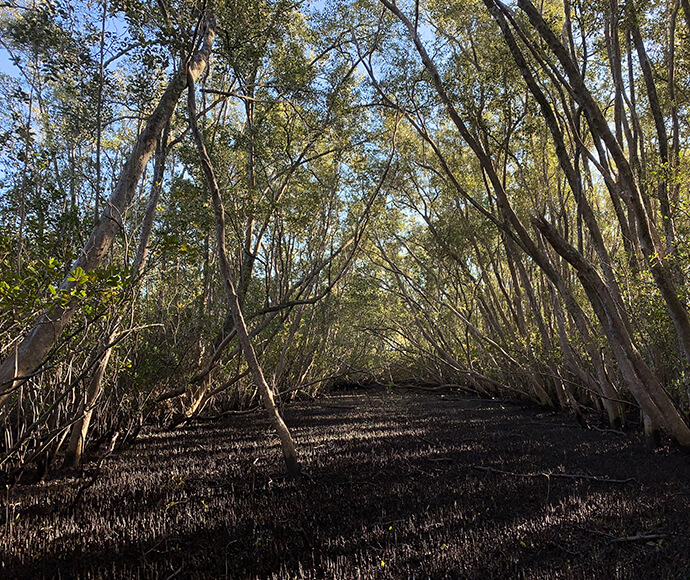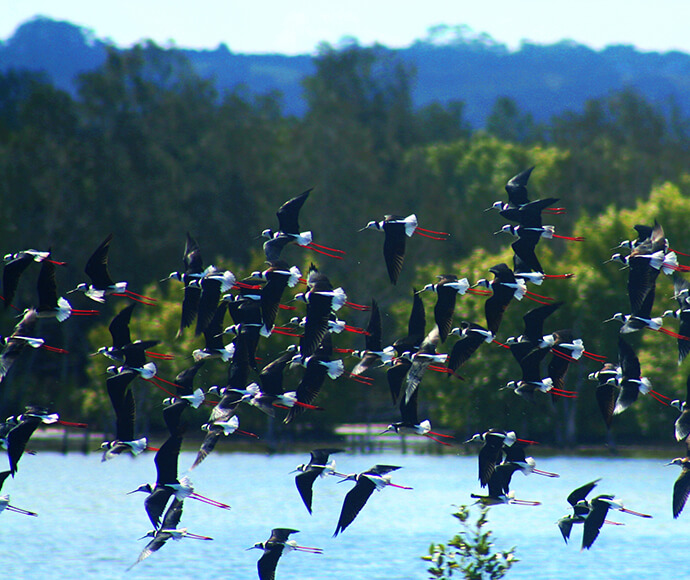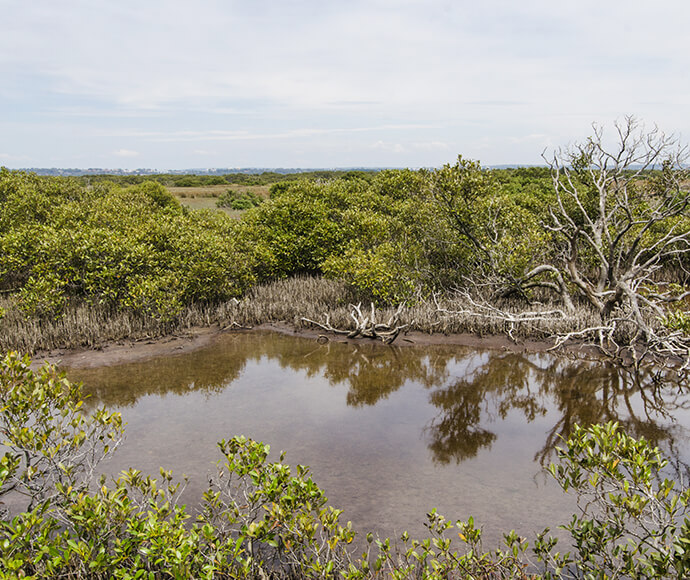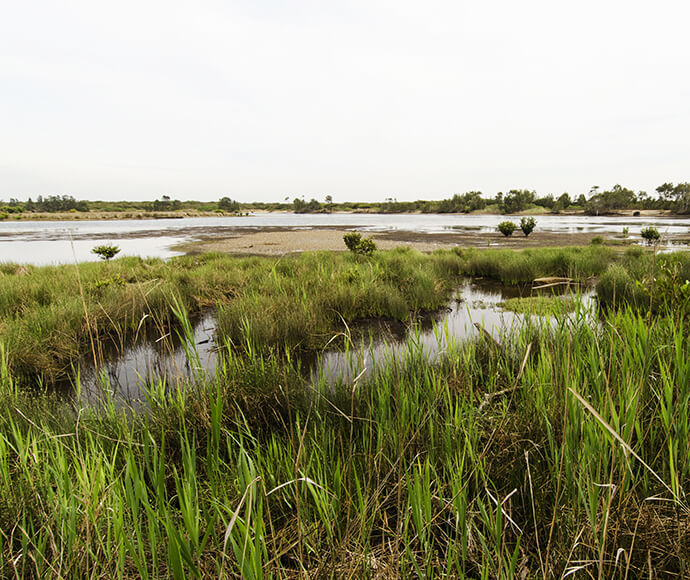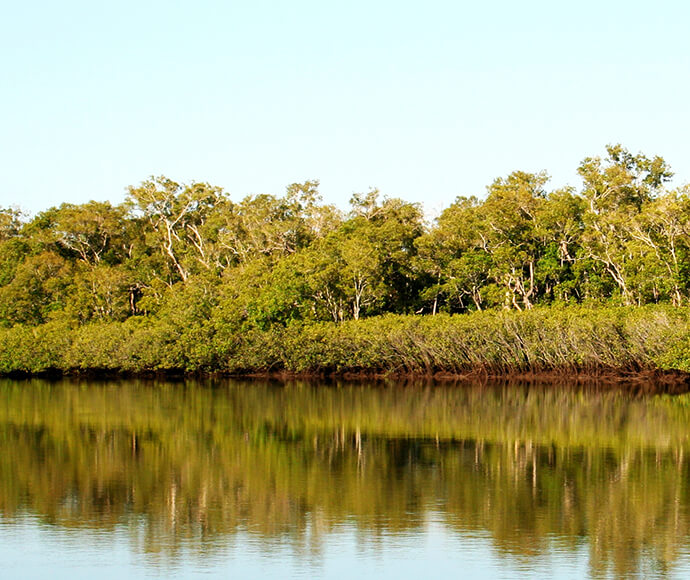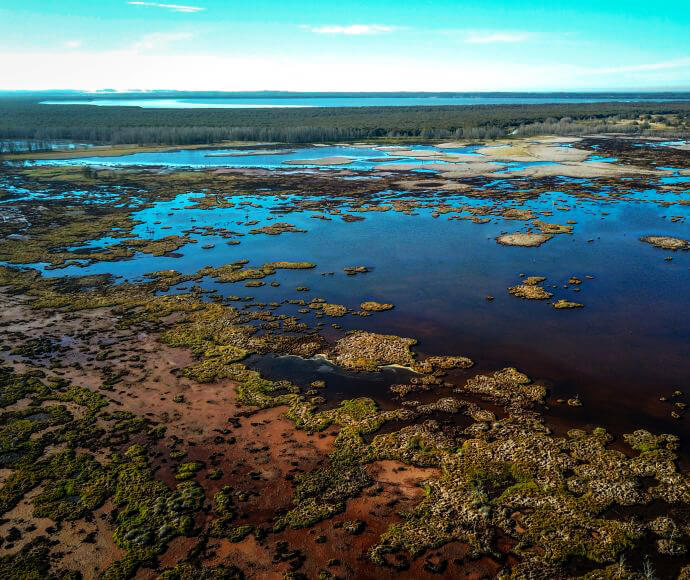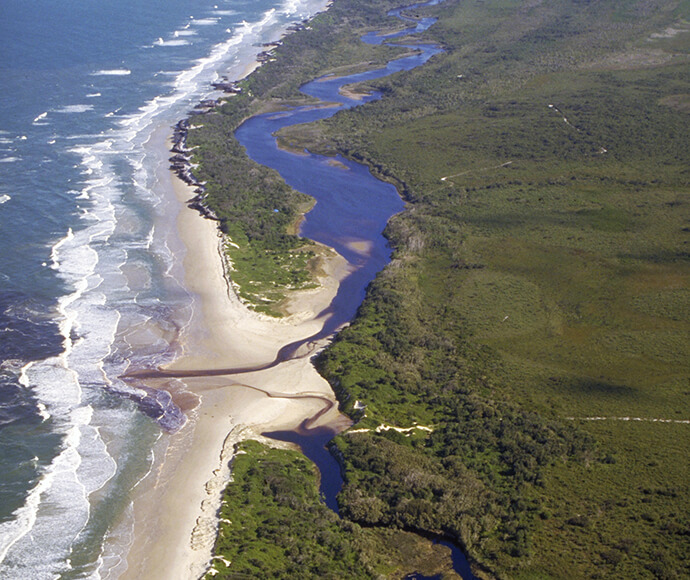What is blue carbon?
Blue carbon is the term used to describe the carbon captured and stored by marine and coastal ecosystems. Blue carbon ecosystems, which include seagrass, mangroves and saltmarsh, can store substantially more carbon per area than land-based forests and, if undisturbed, can store this carbon in soils for many years.
Projects that restore blue carbon ecosystems, such as the reintroduction of tidal flows to restore coastal wetlands, can help deliver significant emissions reductions and may enable carbon credits to be earned.
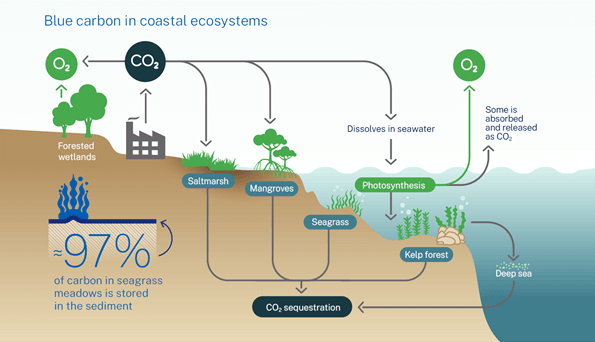
Carbon dioxide dissolves in salt water, is absorbed by coastal and marine ecosystems and stored in sediment. 97% of carbon in seagrass meadows is stored in the sediment.
Why is there a need for action?
In addition to emissions reduction, blue carbon ecosystems provide a range of co-benefits to landholders, businesses and the community through improved water quality, coastal protection, breeding habitat for commercial and recreational fishes, tourism, and Aboriginal cultural benefits.
However, we are losing these ecosystems. Since European settlement across Australia, we have lost approximately:
- 50% of saltmarshes
- 52% to 78% of mangroves
- 20% to 26% of seagrass meadows.
Recognising the numerous benefits that blue carbon ecosystems provide, the NSW Government is taking action to ensure effective conservation of existing blue carbon ecosystems and providing support for the delivery of blue carbon projects.
NSW Blue Carbon Strategy 2022–2027
The NSW Blue Carbon Strategy 2022–2027 provides a roadmap to support blue carbon projects in New South Wales which restore coastal and marine biodiversity and ecosystems, while working towards our Net Zero goals. It aims to provide the catalyst for action, increase participation in the emerging blue carbon market and leverage the many co-benefits of blue carbon projects, such as improved water quality, coastal protection and enhanced habitat for fish and birds.
Delivering targeted action
The strategy identifies 5 overarching priorities and the actions the NSW Government will deliver under each priority over the next 5 years.
- Conserving blue carbon ecosystems and supporting their adaptation and migration.
- Delivering blue carbon projects on public, private and First Nations peoples-owned and managed land.
- Embedding blue carbon in coastal and marine policy planning and management.
- Progressing blue carbon research.
- Promoting blue carbon investment.
Working with all levels of government, industries, landowners and communities to conserve existing blue carbon ecosystems.
Action 1.1: Determine the effectiveness of blue carbon ecosystem legislative protection, conservation and climate change adaptation mechanisms.
Action 1.2: Support private and public land covenanting arrangements and other funding options to manage and conserve blue carbon ecosystems.
Action 1.3: Investigate opportunities to support seagrass and seaweed ecosystem conservation projects.
Action 1.4: Promote and support the conservation, adaptation and migration of blue carbon ecosystems by the community and organisations on public and private land.
Delivering 10 new blue carbon projects, addressing barriers to delivery of new blue carbon projects and providing advice to land managers.
Action 2.1: Explore options that address landholder hesitancy, remove financial barriers and deliver Clean Energy Regulator registered projects.
Action 2.2: Identify and progress 10 new sites for blue carbon restoration with potential for registration with the Clean Energy Regulator.
Action 2.3: Provide advice, guidance and support to landholders and primary producers to help their decision making.
Action 2.4: Support First Nations peoples and their communities to integrate blue carbon projects into Sea Country management.
Action 2.5: Progress blue carbon demonstration projects at Duck Creek Agricultural Research Station, Ballina and the Everlasting Swamp wetland complex.
Encourage and enable blue carbon projects at different scales by streamlining approvals, integrating blue carbon projects into coastal management programs and facilitating uptake through the Marine Estate Management Strategy.
Action 3.1: Review the NSW planning system to streamline approvals and enable blue carbon restoration projects.
Action 3.2: Support councils to integrate blue carbon projects in coastal management programs and transition land uses on low-lying floodplains vulnerable to extreme events and climate change.
Action 3.3: Determine Marine Estate Management Strategy opportunities that facilitate the uptake of blue carbon projects.
Targeted research with key partners to deliver research priorities, identify blue carbon opportunities and support emerging restoration projects.
Action 4.1: Undertake a gap analysis, publish a research prospectus and work with key partners to identify potential funding pathways to deliver research priorities.
Action 4.2: Understand and improve the valuation of blue carbon ecosystem services and the benefits of restoration and conservation.
Action 4.3: Explore opportunities for a pilot kelp forest restoration project in New South Wales.
Increase investment in blue carbon markets and natural capital by quantifying the ecosystem services and benefits provided by blue carbon projects and investigating and piloting novel financing models.
Action 5.1: Quantify and value ecosystem services and associated benefits to drive investment in blue carbon.
Action 5.2: Engage with stakeholders to investigate blue carbon financing models and pathways.
Action 5.3: Pilot the first NSW Government-endorsed Blue Carbon Instrument by 2025 and grow the blue carbon market in New South Wales.
Download
More information
- Carbon positive by 2028
- Natural capital
- Blue Carbon – University of Wollongongopens a new window
- Blue Carbon – Water Research Laboratoryopens a new window
- Coastal Blue Carbon Ecosystemsopens a new window
- Marine estate management strategyopens a new window
- NSW Marine Estate – A healthy coast and seaopens a new window
- Tidal restoration of blue carbon ecosystems methodopens a new window
